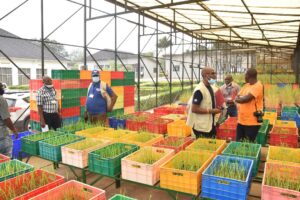
Wars ripped apart the social fabric of the Mekong basin in the 1960s and 1970s, bringing suffering and uncertainty to millions of Southeast Asians. However, several nations of the Greater Mekong Subregion (GMS), one of Asia’s most important rice bowls, have made incredible steps toward recovering from those terrible times—thanks in no small part to rice research. The International Rice Research Institute (IRRI), with the enduring support of concerned donors such as the Australian Agency for International Development, the Swiss Agency for Development and Cooperation (SDC), and the Asian Development Bank, has helped the people of the GMS regain their food security in the aftermath of the conflicts (see Rice and life along the Mekong River on page 4 and Research: Cambodia ushers in new era on page 16).
The GMS includes Cambodia, Laos, Myanmar, Thailand, Vietnam, and China’s southern provinces of Yunnan and Guangxi (see map, above right). IRRI’s success here, while impressive, is incomplete and some dreams are yet to be fulfilled, according to Gary Jahn, IRRI’s representative and coordinator for the Institute’s new office in the GMS. With 25% of the Subregion’s inhabitants (some 75 million poor rice growers and consumers) still below the poverty line, much work remains to be done.
“Poor rural families growing rainfed rice in unfavorable environments have not yet reaped the benefi ts of rice research,” says Dr. Jahn. “These include farmers growing rice in drought- or flood prone areas, in saline or other poor quality soils, or in unsustainable slash-and-burn systems.”
In 2006, some of these age old problems of Asian rice farmers were accentuated with floods, drought, and pests that hit the GMS particularly hard. In Thailand, thousands of farmers saw their crops inundated by record flooding that also affected Cambodia and Laos,
while in Vietnam, farmers watched helplessly as insects destroyed rice worth millions of dollars in one of the worst pest outbreaks in recent history. Because these climate-related events are predicted to continue well into the future, IRRI researchers are accelerating their efforts to overcome these problems by tailoring the rice plant, or the way it is grown, for these harsh environments.
For example, IRRI and the GMS’s six national agricultural research and extension systems (NARES; the institutions and organizations responsible for developing and disseminating rice technologies in IRRI’s partner countries) have initiated many activities to improve rice production, especially in unfavorable areas, aimed at producing economic and environmental benefits (see table on page 17 and People: providing help on pages 18-19).
“The main challenge, in the immediate future,” says Dr. Jahn, “is coordinating between and among various rice research and development initiatives in the Subregion. Since IRRI, donors, and the national governments have invested considerable capital and resources in conducting studies and designing projects, it is crucial that these efforts be complementary, rather than contradictory or competitive.”
between and among various rice research and development initiatives in the Subregion. Since IRRI, donors, and the national governments have invested considerable capital and resources in conducting studies and designing projects, it is crucial that these efforts be complementary, rather than contradictory or competitive.”
The mechanism to meet this challenge became a reality on 12 January 2007 in Vientiane, Laos, when a Memorandum of Understanding (MOU), which established a new IRRI offi ce for the GMS, was signed and a ribbon-cutting ceremony marked the official opening. In signing the historic document, IRRI Director General Robert Zeigler and Lao Minister for Agriculture and Forestry Sitaheng Rasphone (left and right, respectively, in photo) confirmed that IRRI’s framework for regional cooperation logically complements the Institute’s continued strong relationship with Laos.
“This MOU gives full cognizance to the existing commitment of IRRI to rice research in the GMS,” said Dr. Zeigler during the ceremony. “To this end, IRRI and the NARES of the six nations will formulate an agreed strategy for rice research collaboration and technology transfer to improve food security, reduce poverty, improve livelihoods, and protect the environment of the Subregion. Coordinating our research efforts here will increase the pace and quality of development.”
Minister Sitaheng added: “This MOU is an important indication of the way both IRRI and Laos are positioning themselves to respond to regional challenges in rice research. The heart of that response is a research partnership for the benefit of Laos and its neighbors. Laos is proud to be selected as the hub for rice research in the GMS. It is a symbol of our progress in science and our reputation as a good neighbor.”
The Agriculture Minister pointed out that the 16-year Lao IRRI collaboration has resulted in the conservation of 15,000 samples of traditional rice varieties, the establishment of a National Rice Research Program, the release of 18 modern varieties, and a 70% increase in rice production since 1990.
Why locate the IRRI-GMS Office in Laos? There are several good reasons. All rice ecosystems of the GMS are represented in Laos, which has the greatest diversity of rice and the largest collection of indigenous rice accessions in the region. Laos is geographically the central GMS nation, sharing a common border with all of the other five countries. As such, Laos is close to the Mekong River Commission and other bodies dealing with the GMS. Further, there is high potential for the country to contribute to and gain from having a pivotal role in the GMS rice research networks, and capacity building in Laos needs to continue.
The Lao-IRRI Rice Research and Training Project (known simply as the Lao-IRRI Project), which concluded in December 2006, was the longest running bilateral project in IRRI’s history (see Genuinely Lao on pages 22-27 of Rice Today Vol. 5, No. 2). Through the IRRI GMS Office, technical support will continue for the research programs initiated in the Lao-IRRI Project. With generous support from SDC, the Lao-IRRI Project has also been one of IRRI’s most successful efforts for building national research capacity, improving rice production, and preserving the diversity of rice germplasm (rice seeds and tissues).





